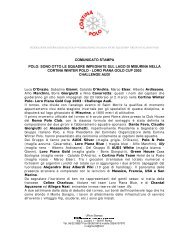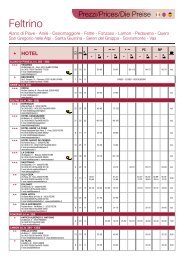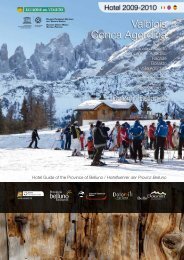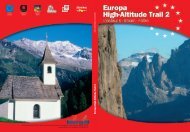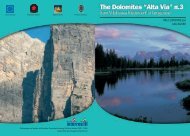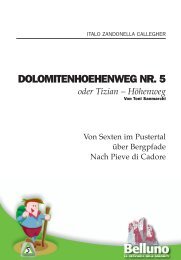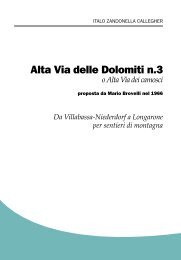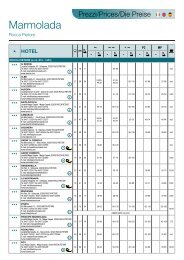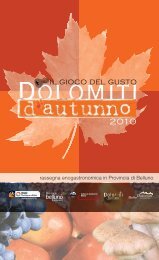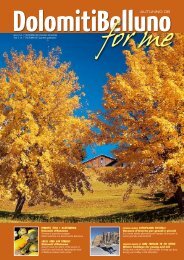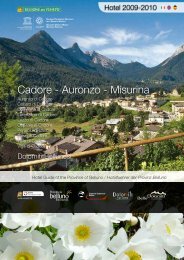Dolomiti Belluno Numero 1
Dolomiti Belluno Numero 1
Dolomiti Belluno Numero 1
Create successful ePaper yourself
Turn your PDF publications into a flip-book with our unique Google optimized e-Paper software.
ITINERARI nella natura<br />
PrIMAVErA ALLE POrTE… del Parco Nazionale <strong>Dolomiti</strong> bellunesi<br />
SPrING IS AT THE GATES…<br />
of the <strong>Dolomiti</strong> bellunesi National Park<br />
<strong>Dolomiti</strong> Bellunesi National park: 32,000 hectares of unspoilt nature, easily<br />
reachable from the cities of the veneto plain. The park occupies the most<br />
southerly part of the Dolomites, the part lying amid Feltre, <strong>Belluno</strong>, Longarone,<br />
the val di Zoldo and the Agordo basin. The vette Feltrine, Cimonega, pizzocco,<br />
monti del Sole, Schiara and pramper are just a few of the massifs contained<br />
inside the park; mountains which are still not very well-known among the<br />
general public, but which offer the visitor extraordinary landscapes rich in a<br />
range of animal and plant species unique to the area.<br />
As spring unfolds, nature begins to stir in the <strong>Dolomiti</strong> Bellunesi National park.<br />
Crocuses, primulas and narcissuses are the first to flower in this season, in<br />
the lower altitude areas; over the next few months, they will be followed by<br />
Parco Nazionale <strong>Dolomiti</strong> Bellunesi - P.le Zancanaro, 1 - 32032 Feltre BL - Tel 0439.3328 - ente@dolomitipark.it - www.dolomitipark.it<br />
VOGLIA DI NATURA, voglia di escursioni<br />
parco Nazionale <strong>Dolomiti</strong> Bellunesi: 32.000 ettari di natura incontaminata a due passi<br />
dalle città della pianura veneta. il parco occupa la parte più meridionale delle <strong>Dolomiti</strong>,<br />
quella compresa tra Feltre, <strong>Belluno</strong>, Longarone, la val di Zoldo e la conca agordina.<br />
vette Feltrine, Cimonega, pizzocco, monti del Sole, Schiara, pramper, sono solo alcuni<br />
dei massicci montuosi compresi nel perimetro del parco. montagne ancora poco note al<br />
grande pubblico, che offrono al visitatore paesaggi straordinari animati da una flora e<br />
una fauna uniche al mondo. Con l’arrivo della primavera la natura si risveglia anche nel<br />
parco Nazionale <strong>Dolomiti</strong> Bellunesi. in questa stagione iniziano, alle quote più basse, le<br />
fioriture di crochi, primule e narcisi, che saranno seguite, nei prossimi mesi, dalle altre<br />
1730 specie che compongono la straordinaria flora del parco.<br />
Anche gli animali riprendono la loro attività. A primavera i boschi in quota risuonano<br />
dei canti territoriali del gallo cedrone e dei “soffi” e “rugolii” emessi dai fagiani di monte<br />
che combattono per contendersi le femmine. Con lo scioglimento della neve ricompaiono<br />
in superficie anche le marmotte, che il parco ha reintrodotto nel proprio territorio<br />
lo scorso anno e che hanno trascorso l’inverno nelle loro tane sotterranee. il disgelo<br />
alimenta torrenti e cascate. per chi voglia effettuare una piacevole passeggiata primaverile<br />
a fondo valle si consiglia un giro in val del mis per ammirare i cadini del Brenton,<br />
splendide vasche naturali scavate dall’acqua, e la cascata della Soffia.<br />
Gianni Poloniato<br />
Enrico Vettorazzo<br />
All’inizio della primavera, verso il mese di aprile, è spesso già possibile percorrere l’itinerario che porta alla chiesetta di San Giorgio (m. 1355), situata a nord di <strong>Belluno</strong><br />
nel territorio del parco Nazionale delle <strong>Dolomiti</strong> Bellunesi. Dal capoluogo si raggiunge in auto il paese di Tisoi (km 5 da <strong>Belluno</strong>), quindi, passata la latteria del paese, si<br />
gira a sinistra e si prosegue per circa due chilometri, percorrendo una strada carrozzabile fino a Casera Zòppa, a quasi 900 metri di altitudine. Qui la carrozzabile finisce.<br />
inizia dunque l’escursione tra radure e boschi misti di conifere e latifoglie (seguire le indicazioni per Forcella San Giorgio, sentiero n. 510). Dopo aver attraversato un<br />
ruscello, si incrocia il sentiero proveniente da Barp: si tiene la destra, poi, passato un piccolo e simpatico arco, il percorso diventa più ripido ed il bosco tende a diradarsi<br />
sempre più. La maggior fatica è comunque ricompensata da magnifici panorami sia verso la valbelluna che verso le selvagge vette poste a settentrione. poco prima della<br />
chiesetta il sentiero si biforca: si prosegue a sinistra seguendo l’indicazione per il monte peron, lasciando alla propria destra il tracciato che conduce alla pala Alta. Dopo<br />
circa un’ora di cammino dalla partenza, si giunge alla Chiesetta di San Giorgio, eretta nel 1500 dagli abitanti di Tisoi e Libano, i quali fin lì salivano nel mese di maggio per<br />
invocare l’acqua dopo l’aratura dei campi.<br />
Manuel Kuehl<br />
Riferimenti cartografici / Map references:<br />
1:25.000 Tabacco f.024;<br />
1:30.000 Provincia di <strong>Belluno</strong> – <strong>Belluno</strong> Foglio Nord<br />
© Manuel Kuehl<br />
© Archivio PNDB<br />
the remaining 1730 species which make up the extraordinary flora of the<br />
park. The animals too spring back to life as the new season commences.<br />
in spring the mountain woodlands resound with the territorial cries of the<br />
capercaillie, and the “coos” and “pops” of the mating call of the black grouse as<br />
they fight for females. As the snow melts, another resident of the park resurfaces:<br />
the marmots, which were reintroduced into the park last year, and have<br />
spent the winter in their underground burrows. As the ice melts, torrents and<br />
waterfalls swell. For those who fancy a pleasant spring walk at the bottom<br />
of the valley, we suggest the val del mis, where you can admire the Soffia<br />
waterfall and the Cadini del Brenton potholes, splendid natural cavities in the<br />
rock worn by the water.<br />
FOR HIKING FANS and nature lovers<br />
At the beginning of spring, towards mid-April, it is often already possible to embark upon the<br />
hiking itinerary which leads to the little church of San Giorgio (1,355 m.), north of <strong>Belluno</strong>, in the<br />
area of the <strong>Dolomiti</strong> Bellunesi National park. From the city of <strong>Belluno</strong>, drive to the village of Tisoi (5<br />
km away); then, after the village dairy, turn left and continue for another two kilometres along a<br />
carriage road until Casera Zòppa, at an altitude of almost 900 metres. The carriage road ends here,<br />
and the hike begins, amid clearings and mixed broadleaf and conifer woodland (follow the signs for<br />
Forcella San Giorgio, path no. 510). After crossing a stream, you meet the path which comes from<br />
Barp; keep right, then, after a charming little arch, the route becomes steeper and the woodland<br />
increasingly sparse. Your efforts will be rewarded, however, with the stunning views both out<br />
towards the valbelluna and towards the wild peaks to the north. Just before the little church the<br />
path forks; continue left, following the signs for monte peron, leaving the trail which leads to pala<br />
Alta behind you on the right. After about an hour’s walk from the departure point, you reach the<br />
little church of San Giorgio, built in 1500 by the people of Tisoi and Libano, who used to climb up<br />
to it every year in may to pray for rain after the fields had been ploughed.<br />
THE OSIERY OF CE LARDA:<br />
a green lung just 10 minutes<br />
out of the city<br />
The natural oasis of the Osiery of<br />
Cellarda lies just a few kilometres from<br />
Feltre town centre, surrounded by<br />
the hamlets of Cellarda, Nemeggio e<br />
villapaiera. The main function of this<br />
Animal and plant population Nature<br />
reserve is to safeguard biodiversity,<br />
and it also offers teaching, educational,<br />
recreational and study activities. The<br />
reserve is situated on alluvial terrain,<br />
and the range of different natural environments<br />
within it – from humid areas to pastureland<br />
and grassland to spontaneous woodland – has<br />
facilitated the development of a rich variety of<br />
flora and fauna. Around 400 arboreus species<br />
and some 50 nesting species are present in<br />
the few dozen hectares which make up the<br />
oasis: so many, in fact, that we can almost speak of “cohabitation” among<br />
different species. A significant number of mammals can also be spotted<br />
quite frequently in the reserve: roe deer, deer, fox, badger, weasel and<br />
hedgehog, to name but a few.<br />
There are numerous walking paths in the area; they present no particular<br />
difficulties, and are thus accessible to everyone. inside the Osiery there<br />
are also a riding ground and a riding school, open all year round and<br />
particularly popular in the summer, where visitors to the reserve can try<br />
their hand at horse riding.<br />
© Archivio Ufficio Territoriale per la Biodiversità (UTB) - BL<br />
© Archivio Ufficio Territoriale per la Biodiversità (UTB) - BL<br />
Comando Stazione Forestale al Vincheto /<br />
Osiery Forest Rangers’ Headquarters - tel. 0439 89520<br />
Corpo Forestale dello Stato /<br />
Italian State Forestry Corps - tel. 0437 944830 – ex_asfd.belluno@corpoforestale.it<br />
ITINERARIES NATURE<br />
IL VINCHETO DI CELLARDA:<br />
un polmone verde a 10 minuti<br />
dalla città<br />
L’Oasi naturalistica del vincheto di Cellarda si trova a pochi chilometri dal centro<br />
di Feltre, tra le frazioni di Cellarda, Nemeggio e villapaiera. Si tratta di una riserva<br />
Naturale di popolamento Animale e vegetale che, oltre a presentare funzioni didattiche,<br />
educative, ricreative e di studio, ha come principale compito la salvaguardia<br />
della biodiversità. il terreno sul quale sorge la riserva è alluvionale e la diversificazione<br />
degli ambienti naturali ivi presenti -da quello umido, a prati e pascoli, a boschi<br />
spontanei- ha favorito lo sviluppo di una ricca varietà floro-faunistica: sono circa<br />
400 le specie arboree e circa 50 le specie nidificanti che hanno trovato rifugio nelle<br />
poche decine di ettari che costituiscono l’oasi, tanto che gli stanziamenti giungono<br />
quasi alla “coabitazione” tra specie diverse. Anche la categoria dei mammiferi annovera<br />
parecchie specie, tra le quali il capriolo, il cervo, la volpe, il tasso, la donnola, il<br />
riccio, tutti animali avvistabili con una certa frequenza nell’Oasi.<br />
<strong>Numero</strong>si sono gli itinerari pedonali presenti nell’area: essi non presentano<br />
particolari difficoltà di percorrenza e si rendono dunque accessibili a tutti. All’interno<br />
del vincheto sono inoltre attivi una scuola di equitazione ed un maneggio, fruibili<br />
nell’arco di tutto l’anno e soprattutto nel periodo estivo, che favoriscono l’avvicinamento<br />
a questo sport da parte dei turisti che frequentano la riserva.<br />
Daniela Cecchet<br />
Una giornata nel bosco a Passo<br />
Digola di Campolongo di Cadore<br />
il bosco della Digola (m. 1009 -2586) si trova<br />
al centro dell’anfiteatro dolomitico costituito<br />
dalle <strong>Dolomiti</strong> pesarine: zona vincolata, il bosco<br />
costituisce l’habitat naturale di numerose specie<br />
ornitologiche, quali il Gufo reale ed il Gallo<br />
Cedrone.<br />
per coloro che desiderano avventurarsi alla<br />
scoperta di questo splendido scenario naturale,<br />
la Baita Digola propone una gita da effettuarsi in<br />
pulmino (max. 9 posti) con sosta per il pranzo<br />
© Hotel Villanova<br />
tipico presso la baita. All’arrivo, nell’attesa del<br />
pranzo, gli ospiti potranno effettuare una breve escursione al passo Digola, belvedere<br />
d’eccezione che offre una meravigliosa veduta delle famose montagne<br />
che circondano Cortina d’Ampezzo – il Cristallo, la Tofana, il passo Falzarego.<br />
Nel pomeriggio è previsto il rientro a piedi lungo il facile sentiero, oppure in<br />
pulmino.<br />
Vanda Baldissarutti - Amelio Casanova<br />
A day in the woods at the Digola<br />
Pass, Campolongo di Cadore<br />
The Digola wood (1,009 - 2,586m) is located in the centre of the dolomite<br />
amphitheatre of the <strong>Dolomiti</strong> pesarine. The wood has a particular protected<br />
status, with restrictions on the activities which can be carried out there, and<br />
is the natural habitat of a large number of bird species, such as the eagle Owl<br />
and the Capercaillie. For visitors who fancy venturing out into this splendid natural<br />
landscape, the Baita Digola mountain hut offers a trip by minibus (max. 9<br />
people), with a break for a typical lunch at the hut. On arrival, before lunch is<br />
served, guests can go on a brief hike up to the Digola pass, from where there<br />
are spectacular views to be had out over the famous mountains which encircle<br />
Cortina d’Ampezzo (the Cristallo, the Tofana) and the Falzarego pass. in the<br />
afternoon, visitors can take the minibus back to the departure point, or walk<br />
back along the easy return path.<br />
Hotel Villanova - tel. 393 5206343 – info@hotelvillanova.com<br />
Ufficio Informazioni turistiche S. Stefano di Cadore - tel. 0435 62230 - santostefano@infodolomiti.it



